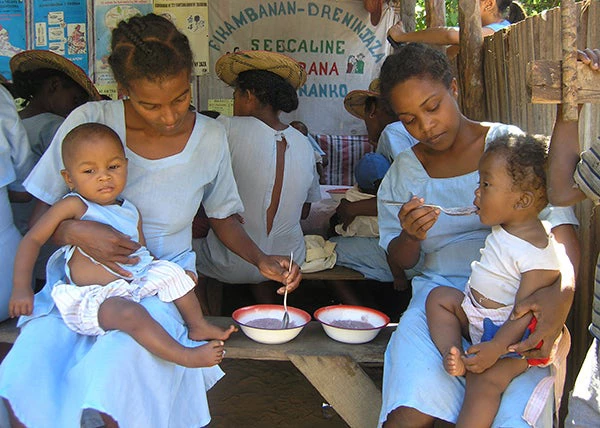
Soanierana (north east Madagascar) after a cooking demonstration focused on preparing
nutrient rich food.
Photo: Erick Rabemananoro
In Analamanga, Madagascar, young women stand with their babies at a Programme National de la Nutrition Communautaire (PNNC) center, one of Madagascar’s community nutrition sites. A nutrition worker cross-checks the weight and age of a six-month-old girl, diligently recording the figures. For many new mothers, the weight of their baby is the most important indicator of their child’s health. But in fact, height is the key metric for understanding their future health and development.
Statistically, many Malagasy children’s heights will fall woefully under the average of their peers -- a potential sign of stunting. Stunting, where children fail to achieve their potential height for their age, is not a simple growth issue. It is often accompanied by developmental problems and irreversible cognitive damage that translates to poor school and employment outcomes later in life.
The World Health Organization estimates that around 160 million children under the age of five are stunted globally. In Madagascar, the rates are among the highest in the world -- impacting 50% of children under five.
The global community has increasingly recognized that the current rates of stunting and malnutrition have devastating effects on individuals and national economies. In recognition of these high costs, the Sustainable Development Goals set a target to end all forms of malnutrition by 2030, including achieving the internationally agreed targets on stunting and wasting in children under five years of age by 2025.
While recent advances in research have helped us understand factors that contribute to stunting, from poor maternal health and nutrition to hygiene practices, addressing the complex causes in our interventions have proven to be far more challenging.
Learning what works
Our evaluations often tell mixed stories about where programs may be having impact and where or why they may be failing. A World Bank study found that while many nutrition interventions had a positive impact on children’s height, weight and/or birth weight outcomes, there was no simple answer to the question of “what worked.”
This is the challenge currently facing Madagascar’s leaders, who have turned to adaptive learning and experimental program design to determine what works in this complicated field.
Madagascar’s National Community Nutrition Program has been running in its various forms since 1993. Today, the program includes 7,000 community nutrition sites targeting 2.1 million mothers and children under five in rural areas.
At the start, the program was impressive in scale and intensity, but a series of political and economic crises diluted some of its initial successes. Against this backdrop, the results of a large-scale multi-round impact evaluation (1998-2011) showed that while the program had a small, significant effect on improving weight for age (i.e. reducing the prevalence of underweight children), it showed no significant impact on height for age (stunting). In a country with 50% child stunting rates, this was alarming.
With World Bank support, the government used these results to rethink strategic focus and program design, As part of this effort, they explicitly sought to understand why they had failed to make any significant impact on reducing child stunting.
A few issues became clear. Like many countries at the time, Madagascar had fallen into a common trap of underestimating the impact of stunting, and instead focused on underweight children.
Additionally, the prioritization and scale up of the nutrition program had not translated into increased impact. In fact, the scaling up process potentially compromised the intensity and quality of interventions as a whole as it overlooked the importance of quality, training, and workloads of frontline community workers.
The results also suggested that even if the program improved its implementation, the original service delivery approach might not have been enough to make a dent in the 50% stunting level.
These conclusions coincided with new research in the broader nutrition and behavioral change sciences and the introduction of innovative approaches in development. This included the Lancet Series on Child Development (2007, 2011) and the Lancet Series on Nutrition (2008), which set out new evidence in a number of areas and highlighted the importance of focusing programs on the first 1,000 days of a child’s life as well as using integrated approaches to improve child development
Additionally, key members of the Madagascar government visited Bangladesh to hear first-hand how they rapidly reduced stunting between 1997 and 2011. As a result of the exchange, parts of the program were immediately refined and scaled up. Using International Development Association (IDA) resources under the Emergency Support to Critical, Education, Health and Nutrition Services Project, a pilot program was also created to test the efficacy of different interventions through a randomized control trial. This is allowing us to test specific and incremental levels of interventions, with successful components to be scaled-up throughout the country using existing program structures.
The pilot is testing whether intensive counseling, a key factor in Bangladesh’s success, and using Lipid Based Supplementation (LNS) are effective as preventive measures. The pilot is also delivering Early Child Development (ECD) activities at the nutrition sites, normally accessed through pre-school, to address the multi-layered aspects of early cognitive development in children.
The pilot’s midline findings are already showing positive results. For example, we are seeing clear evidence that intensive counseling, combined with LNS when introduced over the first 1,000 days, could be an important intervention in Madagascar and the ECD activities show promise.
The role of human-centered design
Tackling chronic rates of malnutrition also involves highly complex behavioral changes in individuals and societies.
In close collaboration with the World Bank’s Innovation Labs team, the Health, Nutrition, Population Global Practice is collaborating with the government to introduce Human-Centered Design (HCD) or “design thinking” into the national nutrition program. HCD allows researchers to understand beneficiaries and their behaviors on a deeper level. It also allows us to design interventions better suited to beneficiary desires and behavioral tendencies with quick, cheap generation and testing of new approaches to influence people to adopt new behaviors.
The HCD work is already giving us new and actionable information about food preferences and household decision-making patterns that are proving vital for redesigning program interventions.
Countries such as Bangladesh, Senegal and Peru have successfully reversed the trend of endemic stunting and malnutrition by finding the appropriate interventions for their specific contexts – something Madagascar is hopefully also now poised to do.
This is the first in a four-part series about adaptive learning, innovation, behavior change and Human-Centered Design in addressing complex nutrition challenges in Madagascar.




Join the Conversation